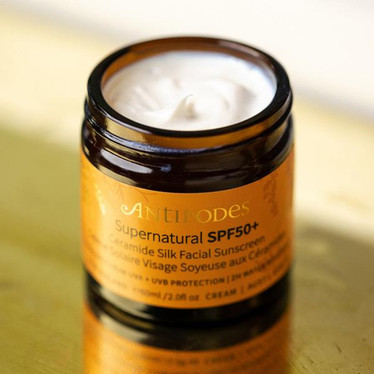
Did you know? In a modern skincare routine, applying sunscreen isn't just about preventing sunburn. In fact, it's a crucial step in protecting your skin from harmful UV rays. Daily use of SPF (sun protection factor) not only shields your skin but also helps maintain its youthful appearance over time.
Understanding mineral vs. synthetic sunscreen
When it comes to sunscreen, there are two main options: mineral and synthetic. There’s a lot of debate on the merits of synthetic vs mineral sunscreen. The fact is they both work, but differ significantly in their ingredients, how they work, and the potential impacts on your skin and the environment.
Mineral sunscreens, also known as physical sunscreens, use naturally occurring minerals like zinc oxide to create a physical barrier on the skin that reflects and scatters UV rays away from the skin's surface. These sunscreens are gentle on sensitive skin and provide immediate protection upon application. Mineral sunscreens are not new, but earlier formulas of this mode of sun protection have a reputation for having an overly thick texture and leaving a white cast on the skin. If you tried earlier versions of natural SPF products and were put off by some of its traits, it might be time to think again.
Synthetic sunscreens, or chemical sunscreens, contain active ingredients such as avobenzone, octisalate, and oxybenzone. These chemicals work by absorbing UV rays and converting them into heat, which is then released from the skin. Because synthetic sunscreens soak into the skin, they can lead to irritation and sensitivity for some people with regular use. They typically need about 20 minutes to become effective after application.
Broad spectrum protection: UVA vs. UVB Rays
It’s incredibly important to choose a sunscreen with broad spectrum protection. In fact, a sunscreen without this protection would not be authorised for sale in New Zealand and Australia, due to our unique environment with harsh UV rays. Broad spectrum sunscreens protect against both UVA and UVB rays, ensuring comprehensive protection against sun damage. But what’s the difference between UVA and UVB rays?
UVA rays are longer wavelengths of light that penetrate deeply into the skin. They contribute to premature aging, such as wrinkles and age spots.
UVB rays, on the other hand, have shorter wavelengths and primarily affect the outer layers of the skin. They are the main cause of sunburn and significantly contribute to skin damage.
An easy way to remember is UVA = aging, UVB = burning.
Introducing Antipodes® Supernatural SPF50+ Ceramide Silk Facial Sunscreen

After years of research and development, Antipodes have now launched their NEW Supernatural SPF50+ Ceramide Silk Facial Sunscreen. Supernatural SPF50+ is independently tested for safety and efficacy on human skin during sun exposure, and listed with Australia’s Therapeutic Goods Administration (TGA), number AUST L 432070.
With a glowy, luminous finish and no white cast, this next-generation zinc oxide sunscreen can be used alone or on top of your favourite Antipodes® serum and moisturiser. It sits beautifully with the rest of Antipodes Skin-Brightening formulations and provides a silky-smooth base for makeup, with no pilling.
The vegan formula is primed with anti-aging ceramides and nourishing plant oils, which unite to help protect the delicate skin barrier and smooth the skin. No added fragrance too.
It’s extremely challenging to create a high protection SPF that feels good on the skin, whilst retaining a 100% natural-origin status. With plastic-free packaging and reef-safe ingredients, it’s an exceptional product that is worth the wait.
How to apply mineral SPF to your face & avoid a white cast
Mineral sunscreens are renowned for their effectiveness and gentleness on sensitive skin, but they can sometimes feel a little heavy or leave a white cast if not applied correctly. Here’s the best way to apply mineral SPF to your face:
- Choose the right formula: Look for mineral sunscreens that are specifically formulated for the face, like Supernatural SPF50+ Ceramide Silk Facial Sunscreen. They should contain nourishing oils and skin-enhancing ingredients to prevent the mineral formulation from drying your skin.
- Preparation: Start with a clean, dry face. Apply a light, water-based moisturiser to ensure skin is hydrated. We love Antipodes Diem Vitamin C Pigment-Correcting Water Cream as the perfect foundation for mineral SPF.
- Amount: Scoop an adequate amount of sunscreen into your fingertips (about a third to a half teaspoon for your face, neck and ears).
- Application: Warm the sunscreen by rubbing between your fingertips, then apply to your face and neck in circular motions.
- Wait before makeup: Allow your SPF to settle for a minute or two before applying makeup.
- Avoid harsh sunlight: Remember, SPF is only one form of sun protection. Wear a hat and sunglasses and try to avoid the summer sun when it’s at its peak.
- Reapplication: Reapply your sunscreen every two hours or immediately after swimming, sweating heavily, or towel-drying.
| Shop Antipodes Supernatural SPF50+ → | Shop Antipodes → |

